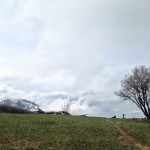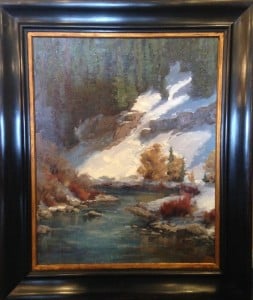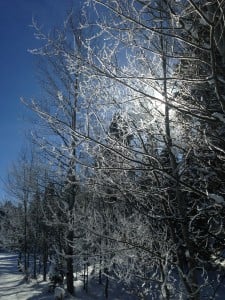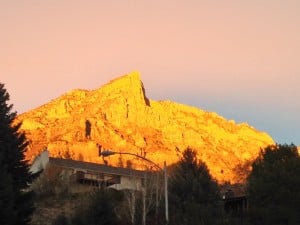 The sociologist Max Weber once described scientific understanding as leading to a disenchantment of nature. This is a paradox, of course, since a sense of amazement is vital to an ethic of care and preservation, and yet we cannot expect to take proper care of land without understanding it works. Weber’s point was perhaps overly simplified, since as writers such as Annie Dillard and Marilynne Robinson have made clear what we gain in understanding about the workings of the world can help to increase our sense of wonder and amazement.
The sociologist Max Weber once described scientific understanding as leading to a disenchantment of nature. This is a paradox, of course, since a sense of amazement is vital to an ethic of care and preservation, and yet we cannot expect to take proper care of land without understanding it works. Weber’s point was perhaps overly simplified, since as writers such as Annie Dillard and Marilynne Robinson have made clear what we gain in understanding about the workings of the world can help to increase our sense of wonder and amazement.
Last night biologist and novelist Steve Peck and I did a reading and led a discussion for the Entrada Institute in Torrey, UT. After an amazing dinner at Café Diablo (highly recommended!), we went to the local bookstore, The Robber’s Roost. Our charge was to talk about “The Enchanted Landscape” and how the nexus of literature, spirituality, and scientific understanding can help stimulate greater awareness and care for the natural world.
If you aren’t already familiar with Steve Peck’s novel, The Scholar of Moab, you need to be. The novel is unlike anything I have ever read, and I suspect is one of the finest works of literature ever produced by a Mormon. What characterizes his book is a kind of magical realism that defamiliarizes his readers with the landscape of Moab so as to then allow us to see it and its surrounding culture as if for the first time. Steve is a serious and highly successful scientist, but I have heard him lecture about the beauty of ants, for example, as if he were in the Louvre. He has a childlike fascination with the world and a deep sense of spirituality that is nurtured by the little discoveries of our connectedness to the world. But perhaps most importantly, he has a fantastical and whimsical imagination that means he will never get bored by the repetitive, the mundane, or the habitual. One of his conclusions in the discussion was that to see the world as enchanted requires a little bit of science, a little bit of faith, and a little bit of the artistic impulse to take of what we see or know and imagine it anew.
In our discussion, people asked about whether or not religious belief can get in the way of our ability to be amazed by or care about the world. Religion, of course, has a tendency to point to the next life, to another world, and by implication to see the particulars of this embodied life as transient distractions. In my book, Home Waters, I tried to insist that this is an improper understanding of Christianity, which as the story of the Supper at Emmaus makes clear is really an intensification of the spiritual and wonderful meaning of the mundane. To pray over our food or to sit under the stars or to take a photograph of a mountainside are all different rituals that help us to remain in a state of astonishment at life’s bounty.
I am less inclined to believe that religion stands in the way and more inclined to believe that our consumer culture has simply run roughshod over our ability to be amazed and over even the deepest implications of our most sacred beliefs. To believe, for example, that the world was created spiritually before it was created physically, as Mormons do, would seem to give us pause before treating the world as some thing to own or to possess, some thing that is a mere extension of our will, or some thing that is merely intended to provide us with certain services or pleasures. We are driven by a lust for entertainment. Many of us spend money primarily on things. Even when we visit places, we seek them as “things” not as enveloping experiences that transform our understanding of our place in the world. We can scarcely consider our own homes as part of nature. Nature is “out there” or at campsites and national parks, but never who we are or where we are when we are doing what we do just to live day to day. As the writer Chip Ward said at the event, we ought to think of a new word other than environmentalism to describe concern for our world. It is not around or outside of us but a part of us. So he suggested embodimentalism, something that seems consistent with belief in a God in the flesh.
Cezanne painted Mt. Saint Victoire over and over again. He never ceased to see it differently. It was never the same mountain. The light changed hourly and seasonally, the colors and moods shifted along its face, and Cezanne I suppose himself was never the same man. He was not a static thing but an embodied organization of matter that moved through space and time and exchanged matter, along with everything else. To see like an artist is to see like an ecologist. It is to see interdependence everywhere. What causes the amazement is the possibility that despite his interdependent biology, he was an individual consciousness compelled to order the world in that idiosyncratic and unique way of his. There may only be one Cezanne, but all of us have the same unique challenge and privilege to see the world in astonishment, again and again.
Steve and Lori Peck and Amy and I stayed at the home of our gracious hosts, Mark Bailey and Kirsten Alley, the publishers of Torrey House Press. Their home sits aloft a small butte facing Boulder Mountain to the south. It is impossible to be in their home and not notice the immediacy of the world through the large windows. After the reading, we sat on some smooth rock outside under the stars in the nippy October air while the canopy of the Milky Way crossed over our heads. For the first time in my life, I saw, with the help of binoculars, the galaxy of Andromeda, a full two million light years away. It appears like a blurred cluster of light behind the piercing brightness of our own galaxy’s stars, a small and faded spot with trillions of its own stars. Just learning a little of the science to understand what I saw made me feel so impossibly small and yet so inexplicably happy. And I felt confident that we will never write and we will never read enough books to finally stop us from being amazed at our own existence.











